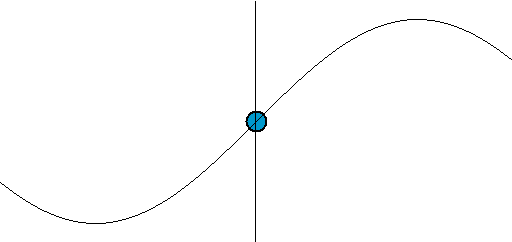A wave is a travelling disturbance. A wave carries energy without transporting matter.
A wave changes the properties of an environment locally and temporarily. For example, when a pebble is thrown into the water, the surface of the water is modified and ripples appear. During an earthquake, the earth's crust transmits the vibrations of the quake. When you clamp a guitar string, you can see it vibrate. All these disturbances are perceptible examples of a wave.
A wave only transports energy from one area to another; it does not transport matter. For example, in the diagram below (right), we can see that the blue ball remains in the same place after the wave has passed; it simply moves up and down according to the rhythm of the wave.


Waves can be very different from one another. Depending on their characteristics, the environment in which they propagate and their type, they can be very diverse.
Waves can be distinguished by the way they propagate or by the environment in which they propagate. Two types of waves depend on the type of propagation:
There are two types of waves that depend on the propagation environment required to transmit the wave:
A transverse wave is a wave that travels perpendicular to the distance travelled in the environment. In other words it goes up and down.
The motion of the ocean's waves represents the trajectory of a transverse wave. It is true that some mechanical waves, such as waves and earthquakes, are transverse waves. Electromagnetic waves are also transverse waves. They are waves of which light is a component.
A longitudinal wave is a wave that propagates parallel to the the environment, which means that it compresses and stretches.
Sound waves, which are mechanical waves, are longitudinal waves.
A spring can have regions of compression and rarefaction.
A mechanical wave is a wave that needs an material environment (matter) to propagate. Water waves, as well as sound and seismic waves are all types of mechanical waves.
Mechanical waves need an material environment (liquid, solid or gaseous) to propagate. For example, ocean waves use water to carry waves, air carries sound and seismic waves travel in the ground.
An electromagnetic wave is a wave that propagates both in a vacuum and in a material environment. Radio waves, light waves and X-rays are examples of electromagnetic waves.
All electromagnetic waves are part of the electromagnetic spectrum. Visible light is only one component of this spectrum. These waves are capable of travelling through a vacuum, which explains why the Sun's rays can reach the Earth's surface by travelling through the interstellar vacuum. In a vacuum, the velocity of electromagnetic waves is | \text {300,000 km/s}|.

